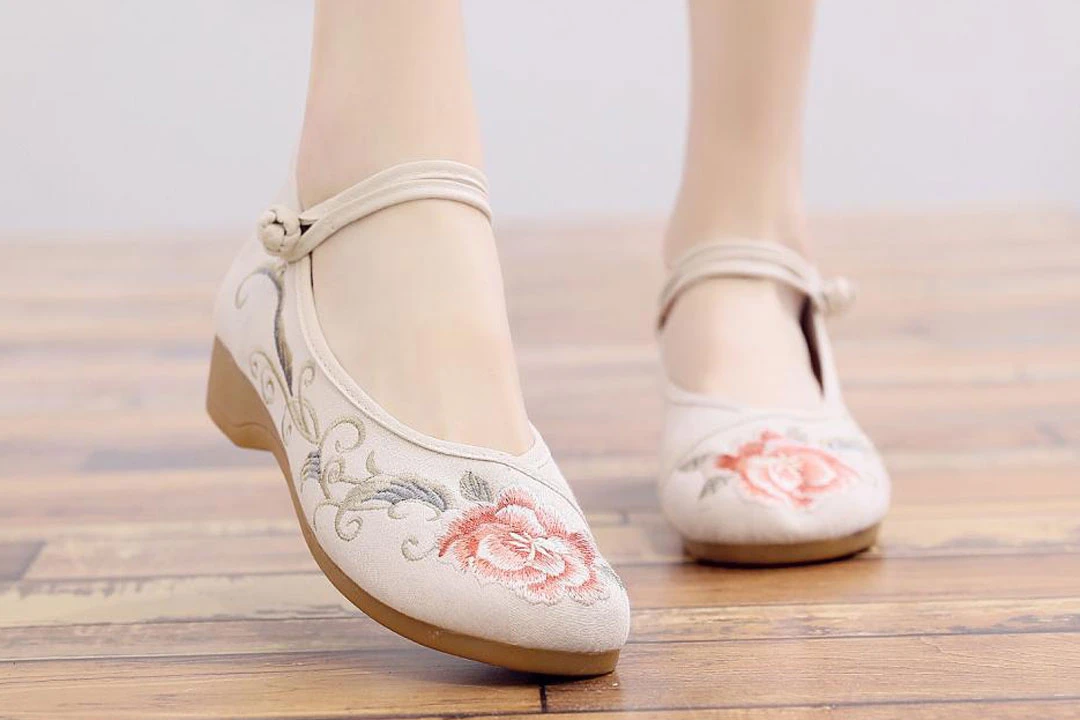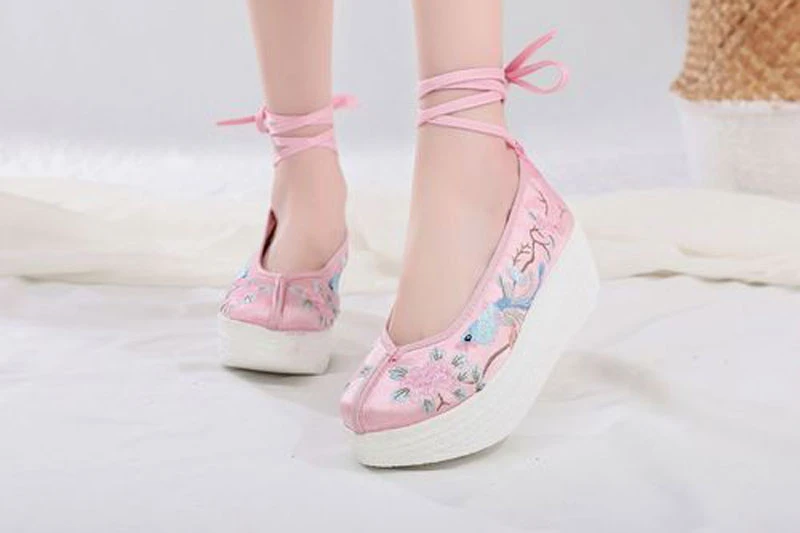In the intricate world of traditional Chinese outfits, the allure of Hanfu extends beyond the garments themselves to the meticulous details that complete the ensemble. One such essential element is the footwear. From the simple yet elegant designs of Hanfu shoes to the historical significance woven into the fabric of Chinese ancient footwear, this comprehensive exploration delves into the evolution, craftsmanship, and symbolism that make Hanfu shoes an integral part of China’s rich cultural heritage.
Traditional Hanfu Shoes: A Dance of Design and Style
Hanfu shoes, while often understated, play a vital role in completing the overall aesthetic of the traditional ensemble. The simplicity of design is intentional, with an emphasis on clean lines and subtle details that enhance the graceful flow of the Hanfu attire.
What shoes are worn with Hanfu?
Traditional styles include:
- Flat Shoes (Ping Jin): These are simple, flat-soled shoes often worn with everyday Hanfu outfits. They provide comfort and ease of movement, making them a practical choice for various occasions.
- Cloth Shoes (Bu xie): Made from silk or cotton, cloth shoes are lightweight and flexible. They feature delicate embroidery or simple patterns, adding a touch of sophistication to the ensemble.
- Embroidered Shoes (Xiu Xie): These shoes boast intricate embroidery, mirroring the patterns found on the Hanfu garments. They are popular for formal occasions, adding a coordinated and polished look to the overall outfit.
Silk, Satin, and Comfort: Materials Used in Crafting Hanfu Shoes
The materials used in crafting Hanfu shoes are carefully chosen to align with the principles of comfort, aesthetics, and cultural significance. Silk and satin, known for their luxurious texture, are common choices that contribute to the overall elegance of the footwear.
- Silk Shoes: Silk shoes offer a smooth and lustrous finish, enhancing the visual appeal of Hanfu shoes. The breathable nature of silk also contributes to the wearer’s comfort.
- Satin Embellishments: Satin is often used for embellishments on Hanfu shoes, adding a touch of opulence to the overall design. Satin ribbons, bows, or embroidered details complement the primary material.
- Comfort-Focused Materials: In addition to silk and satin, Hanfu shoes may incorporate materials like cotton or soft leather for their comfort and flexibility. The goal is to ensure that the wearer can move with ease while maintaining the aesthetic integrity of the ensemble.
Symbolic Footsteps: The Meaning Behind Hanfu Shoe Designs
Hanfu shoes, though seemingly simple, often carry profound symbolic meanings embedded in their design elements. Understanding the symbolism adds depth to the appreciation of these seemingly humble accessories.
- Color Symbolism: Colors play a crucial role in Hanfu shoes. Red, for example, symbolizes good fortune and joy, making red shoes a popular choice for festive occasions.
- Pattern Significance: Intricate patterns, such as floral motifs or auspicious symbols, convey cultural messages. Peonies, for instance, symbolize wealth and prosperity, while dragons represent power and strength.
- Heel Heights: The heel height of Hanfu shoes can also carry meaning. Flat shoes are often associated with modesty and practicality, while slightly elevated heels may denote a more formal or ceremonial context.
Evolution of Chinese Ancient Shoes
The evolution of Chinese ancient shoes is a fascinating journey through the dynasties, each leaving its imprint on the style and design of footwear.
- Han Dynasty Shoes: During the Han Dynasty, flat-soled shoes with upturned toes were prevalent. These simple designs reflected the Han people’s emphasis on practicality.
- Tang Dynasty Innovations: The Tang Dynasty saw the introduction of more intricate designs, with pointed toes and upturned edges. Bright colors and ornate patterns became popular during this era.
- Ming and Qing Dynasty Elegance: The Ming and Qing Dynasties emphasized refinement. Shoes with curled toes and embroidered details became characteristic of this period, reflecting a sophisticated and mature aesthetic.
The Artisanal Techniques Behind Ancient Shoes
The craftsmanship involved in creating Chinese ancient shoes is a testament to the skill and dedication of artisans throughout history. From handwoven fabrics to delicate embroidery, each pair of shoes tells a story of meticulous artistry.
- Hand-Embroidery Techniques: Intricate patterns and motifs are often embroidered by hand, showcasing the artisan’s skill. The choice of thread colors and stitch types contributes to the overall visual impact.
- Fabric Selection: Traditional Chinese shoes are crafted from high-quality materials, often silk or brocade. The careful selection of fabrics ensures durability, comfort, and a luxurious finish.
- Sole Construction: The construction of the sole is a crucial aspect of ancient Chinese shoes. While flat soles are common, certain styles may feature slight elevation or additional padding for comfort.
Iconic Styles Through the Ages
Certain styles of ancient Chinese shoes have become iconic representations of specific historical periods. Understanding these styles provides insight into the fashion preferences and cultural nuances of the time.
- Lotus Shoes (Lian Hua Xie): Worn primarily during the Ming and Qing Dynasties, lotus shoes were characterized by their small size and curved shape. They were symbols of beauty but also reflected societal expectations of women’s foot-binding practices.
- Floral Embroidered Shoes: Across various dynasties, shoes featuring elaborate floral embroidery were favored for their elegance and symbolism. Flowers such as plum blossoms, peonies, and lotuses were common motifs.
- Dragon and Phoenix Shoes: Symbolizing the union of yin and yang, dragon and phoenix motifs adorned shoes during imperial weddings. These intricate designs reflected the importance of harmony and balance in Chinese culture.
From Tradition to Trend
The traditional meets the contemporary in the world of Hanfu shoes as modern designers infuse new life into ancient designs.
Incorporation of Western Styles: Modern Hanfu shoes may incorporate elements of Western shoe design, creating a fusion of cultural influences that appeal to a broader audience.
Fashion Forward Designs: Contemporary Hanfu shoes may feature innovative designs, such as open-toe styles or unconventional materials, catering to diverse tastes while maintaining a connection to tradition.
Footsteps Beyond Borders
Chinese ancient footwear has transcended geographical boundaries, captivating the interest of individuals around the world.
International Fashion Shows: Traditional Chinese shoes have been featured in international fashion shows, bringing these cultural artifacts to the global stage.
Celebrity Endorsement: Influential figures in the fashion industry and celebrities have embraced Chinese ancient footwear, contributing to its popularity and acceptance in the global fashion scene.
Tips on Hanfu Shoe Care and Cultural Sensitivity
Caring for Hanfu Shoes with Respect
- Preserving the beauty and integrity of Hanfu shoes requires careful consideration and proper care techniques.
- Storage Recommendations: Hanfu shoes should be stored in a cool, dry place to prevent damage. Using shoe trees or stuffing them with acid-free tissue helps maintain their shape.
- Cleaning Techniques: Gently clean Hanfu shoes with a soft brush or cloth to remove dust. Avoid exposure to direct sunlight, as it may fade delicate fabrics.
Understanding the cultural significance of Hanfu shoes is essential for making appropriate choices in various social and cultural contexts.
Appropriate Occasions: Consider the formality of the occasion when choosing Hanfu shoes. More elaborate designs may be suitable for formal events, while simpler styles are appropriate for casual settings.
Respecting Traditions: When wearing Hanfu shoes, especially for cultural or traditional events, it’s important to respect and adhere to any specific cultural guidelines or practices associated with footwear.
In the intricate realm of Hanfu shoes and Chinese ancient footwear, every stitch, pattern, and choice of material tells a story of cultural heritage and timeless elegance. As we step into the footsteps of history, we discover a world where tradition and modernity coexist, each pair of shoes bridging the gap between the past and the present. Whether worn with a traditional Hanfu ensemble or integrated into contemporary fashion, these culturally rich artifacts continue to captivate and inspire, leaving an indelible mark on the global landscape of style and expression. As we celebrate the artistry and craftsmanship of Hanfu shoes, we embark on a journey through time, appreciating the footsteps that echo with the cultural legacy of China.


